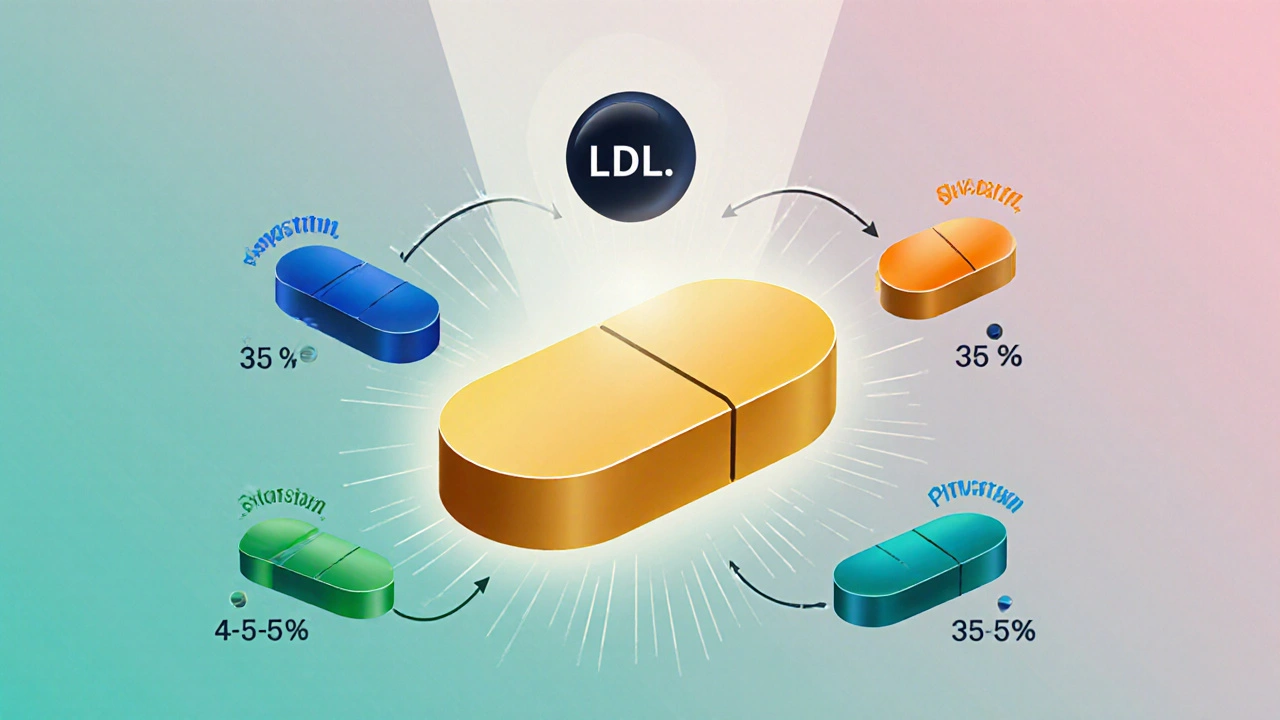
Statin Choice Advisor
Select Your Priority:
Statin Options:
Crestor
Rosuvastatin
Highest potency per mg, minimal drug interactions
Lipitor
Atorvastatin
Proven safety, wide insurance coverage
Zocor
Simvastatin
Most affordable generic option
Pravachol
Pravastatin
Gentlest on liver enzymes
Livalo
Pitavastatin
Balanced potency and low interactions
Recommended Statin:
Select your priorities and click "Find My Best Statin" to get personalized recommendations.
Comparison Table:
| Statin | Brand | Typical Dose (mg) | LDL-C Reduction | Notable Features |
|---|---|---|---|---|
| Rosuvastatin | Crestor | 5-40 | 45-55% | Highest potency per mg, minimal CYP450 metabolism |
| Atorvastatin | Lipitor | 10-80 | 35-50% | Long-standing safety data, broad insurance coverage |
| Simvastatin | Zocor | 5-40 | 25-35% | Cheapest generic, higher risk of drug-drug interactions (CYP3A4) |
| Pravastatin | Pravachol | 10-80 | 20-30% | Least liver enzyme impact, hydrophilic molecule |
| Pitavastatin | Livalo | 2-4 | 30-40% | Balanced potency, low interaction risk, newer entrant |
When doctors talk about lowering bad cholesterol, the name Crestor often pops up. But with several statins on the market, how do you know if Crestor is truly the best fit for you? This guide breaks down Rosuvastatin’s strengths, compares it side‑by‑side with the most common alternatives, and gives you practical tips for making a smart choice.
TL;DR - Quick Takeaways
- Rosuvastatin (Crestor) is the most potent statin per milligram, delivering up to 55% LDL‑C reduction.
- Atorvastatin (Lipitor) offers similar potency but has a longer track record and broader insurance coverage.
- Simvastatin (Zocor) is cheaper but less powerful and interacts with more drugs.
- Pravastatin (Pravachol) is the gentlest on liver enzymes, ideal for patients with mild liver concerns.
- Pitavastatin (Livalo) sits between rosuvastatin and pravastatin in potency, with a favorable side‑effect profile.
How Statins Work - The Basics
All statins share a common goal: they inhibit HMG‑CoA reductase, the enzyme that drives cholesterol production in the liver. By blocking this pathway, the liver pulls more low‑density lipoprotein (LDL‑cholesterol) out of the bloodstream, lowering the risk of plaque build‑up and cardiovascular events.
While the mechanism is uniform, each statin differs in potency, half‑life, metabolism, and interaction profile. Those differences drive the decision‑making process for doctors and patients.
Rosuvastatin (Crestor) - What Sets It Apart
Rosuvastatin is marketed under the brand name Crestor. First approved in 2003, it quickly earned a reputation for high potency and a long half‑life of about 19 hours, allowing once‑daily dosing.
- Typical dose: 5‑40mg per day.
- LDL‑C reduction: 45‑55% at higher doses, making it the most effective statin on a per‑milligram basis.
- Key advantage: Strong efficacy even in patients with genetic hypercholesterolemia.
- Common side effects: Muscle aches (myalgia), occasional headache, and mild increases in liver enzymes.
- Drug interactions: Minimal because it is largely excreted unchanged; however, caution with cyclosporine and gemfibrozil.
Because rosuvastatin is not extensively metabolized by the CYP3A4 pathway, it sidesteps many interactions that plague other statins. For patients on multiple medications, this can be a decisive factor.

Head‑to‑Head: Rosuvastatin vs. Popular Alternatives
| Statin | Brand | Typical Dose (mg) | LDL‑C Reduction | Notable Features |
|---|---|---|---|---|
| Rosuvastatin | Crestor | 5‑40 | 45‑55% | Highest potency per mg, minimal CYP450 metabolism |
| Atorvastatin | Lipitor | 10‑80 | 35‑50% | Long‑standing safety data, broad insurance coverage |
| Simvastatin | Zocor | 5‑40 | 25‑35% | Cheapest generic, higher risk of drug‑drug interactions (CYP3A4) |
| Pravastatin | Pravachol | 10‑80 | 20‑30% | Least liver enzyme impact, hydrophilic molecule |
| Pitavastatin | Livalo | 2‑4 | 30‑40% | Balanced potency, low interaction risk, newer entrant |
The table makes it clear: if you need the biggest LDL drop with minimal pill burden, rosuvastatin takes the lead. If cost is the primary driver, simvastatin and pravastatin are appealing, but you may sacrifice some potency.
Choosing the Right Statin - Factors to Consider
- Target LDL level: Patients aiming for <10% of baseline LDL (often those with existing heart disease) benefit from rosuvastatin or high‑dose atorvastatin.
- Drug‑interaction profile: If you’re on a regimen that includes macrolide antibiotics, antifungals, or HIV protease inhibitors, pravastatin or rosuvastatin are safer bets.
- Kidney function: Rosuvastatin is cleared renally; adjust dose if eGFR <30mL/min. Atorvastatin relies more on hepatic clearance.
- Cost & insurance: Generic simvastatin and pravastatin often have the lowest out‑of‑pocket price. Some UK NHS formularies prefer atorvastatin as first‑line.
- Side‑effect tolerance: Patients with a history of statin‑induced myalgia may start on pravastatin or low‑dose pitavastatin before escalating.
Discuss these points with your clinician; the “best” statin is the one that aligns with your health goals, medication list, and lifestyle.
Common Concerns & Safety Tips
Statins are generally safe, but a few myths linger:
- Myth: Statins cause muscle loss.
Fact: Only a small subset (<0.5%) develop true rhabdomyolysis. Monitoring creatine kinase (CK) levels when symptoms appear is sufficient. - Myth: All statins increase diabetes risk.
Fact: The risk is modest (about 0.1% per year) and outweighs cardiovascular benefits, especially in high‑risk patients. - Tip: Take your statin in the evening (unless you’re on a once‑daily long‑acting type like rosuvastatin) to match the body’s natural cholesterol synthesis cycle.
Regular blood tests every 3‑6 months during the first year help catch any liver enzyme elevation early. If you notice persistent muscle pain, contact your doctor before stopping the medication.
Frequently Asked Questions
Can I switch from simvastatin to rosuvastatin?
Yes. A physician will typically start you on a low dose of rosuvastatin (5mg) and monitor LDL levels after 4‑6 weeks. The switch helps avoid the drug‑interaction issues common with simvastatin.
Is rosuvastatin safe for people with kidney disease?
Rosuvastatin is partially cleared by the kidneys, so dose reduction is recommended if eGFR is below 30mL/min. Your doctor may choose a 5mg daily dose or opt for a statin less dependent on renal excretion.
Why does my doctor prefer atorvastatin over rosuvastatin?
Atorvastatin has a longer history of generic availability and broader NHS coverage, making it a cost‑effective first‑line choice. It also offers a flexible dosing range (10‑80mg) that suits many patients.
Do statins affect vitamin D levels?
Current research shows minimal impact on vitamin D. However, if you’re deficient, supplementing vitamin D while on any statin is safe and may improve muscle comfort.
How long should I stay on rosuvastatin?
Statins are typically lifelong therapies for chronic hypercholesterolemia. Periodic reassessment (every 2‑3 years) helps confirm that the medication remains necessary and effective.
Write a comment
Your email address will not be published.






19 Comments
Interesting breakdown. I like how the tool lets you prioritize potency vs cost. For someone juggling multiple meds, the minimal CYP450 interaction of Crestor looks appealing. Still, I wonder about the long-term safety data compared to Lipitor.
i think the site looks kinda cool but the info is a bit too techy for me. still, its useful if u got a doc to interpret.
The presentation, while aesthetically pleasing, fails to address the profound stewardship required when prescribing high-potency statins. One must consider the delicate equilibrium between efficacy and hepatic tolerance, a balance often neglected in commercial literature. Moreover, the reliance on manufacturer-sponsored outcomes for rosuvastatin warrants cautious scrutiny. It would be prudent to juxtapose these findings with independent meta-analyses. In sum, the tool, though informative, should be employed as an adjunct rather than a definitive arbiter.
Love the vibe, this statin showdown is 🔥!
This is super helpful. i cant believe how many options there are lol.
While the interface is polished, one must not overlook that efficacy data for rosuvastatin derives largely from industry-sponsored trials. Independent head-to-head comparisons with atorvastatin remain limited, especially in diverse ethnic cohorts. Additionally, the purported "minimal drug interactions" claim disregards rare but serious myopathy cases when combined with certain fibrates. It would be advisable to consult a pharmaco‑kinetic specialist before assuming universal safety. In essence, enthusiasm should be tempered with rigorous clinical judgment.
The nature of cholesterol management invites a deeper contemplation of risk versus benefit. One might ask whether the pursuit of ever‑lower LDL truly aligns with the broader goals of wellness. Perhaps the answer lies not solely in the molecule, but in the lifestyle tapestry surrounding it.
When deliberating the optimal statin, it is essential to weigh a multitude of factors that extend beyond mere potency figures. First, the patient’s baseline LDL level sets the stage for how aggressive a therapeutic approach must be, with higher baselines often necessitating a drug with robust LDL‑C reduction, such as rosuvastatin. Second, the pharmacokinetic profile bears significance; for instance, Crestor’s minimal reliance on CYP450 pathways reduces the likelihood of drug‑drug interactions, a crucial consideration for polypharmacy patients. Third, cost considerations cannot be ignored, as generic simvastatin offers substantial savings while still delivering respectable LDL lowering for many individuals. Fourth, the safety profile, especially regarding hepatic enzymes and muscle toxicity, remains paramount; pravastatin’s gentle effect on liver enzymes makes it a favorable option for those with hepatic concerns. Fifth, patient adherence is influenced by dosing convenience-once‑daily regimens, as found with most statins, improve compliance compared to more complex schedules. Sixth, insurance coverage frequently dictates accessibility; Lipitor’s widespread coverage may sway decision‑making in certain health systems. Seventh, emerging evidence around pleiotropic effects, such as anti‑inflammatory benefits, adds another layer of nuance, though these data are still evolving. Eighth, the clinician must consider comorbid conditions like diabetes, where certain statins have shown modest impacts on glycemic control. Ninth, age-related pharmacodynamics suggest lower starting doses for older adults to mitigate adverse effects. Tenth, genetic polymorphisms, such as SLCO1B1 variants, can predispose patients to statin‑induced myopathy, influencing drug choice. Eleventh, lifestyle interventions remain a cornerstone; no statin can replace the benefits of diet and exercise. Twelfth, ongoing monitoring of lipid panels and liver function tests guides dose adjustments over time. Thirteenth, patient preference, informed by education about risks and benefits, should be incorporated into the shared decision‑making process. Fourteenth, the evolving landscape of PCSK9 inhibitors and other lipid‑lowering agents may eventually redefine the role of statins for high‑risk patients. Finally, the ultimate goal is to reduce cardiovascular events, and the evidence supporting high‑intensity statins in secondary prevention remains compelling. In synthesizing these considerations, clinicians can tailor therapy to each individual’s unique clinical picture, optimizing outcomes while minimizing harm.
While the exposition above is undeniably thorough, one must caution against information overload that can obscure practical decision‑making. The emphasis on pharmacogenomics, though scientifically intriguing, may not yet be actionable in everyday primary care. Moreover, the suggestion to prioritize cost could inadvertently compromise efficacy for patients at highest risk. It is also noteworthy that the discourse overlooks the psychosocial dimensions of medication adherence, such as patient beliefs about statins. In light of these observations, a balanced, patient‑centered approach remains the most judicious path forward.
Dude, this statin showdown feels like a blockbuster fight scene! Crestor’s got the power moves, but Lipitor’s the seasoned veteran. Either way, you’re winning if you pick right.
i think we should all share our thoughts so the best choice pops up. sorry for the typo but i hope its clear :) lets help each other find the right med.
I don’t see why anyone would even consider a statin.
Picture this: a statin that dances on the lipid membranes, whispering sweet reductions to LDL. Rosuvastatin tiptoes, while Simvastatin stomps loudly yet cheaply. Choose your rhythm, dear reader.
In the grand tapestry of cardiovascular prophylaxis, the selection of a statin invites rigorous deliberation. One must weigh the empirically substantiated potency of rosuvastatin against the extensive longitudinal safety data of atorvastatin. Moreover, the socioeconomic dimensions, encompassing insurance formularies and patient out‑of‑pocket expenses, warrant equal consideration. Ultimately, a nuanced, evidence‑based synthesis should guide therapeutic determination.
Feeling the weight of decision making here its completely understandable. Remember you’re not alone many have walked this path before
From a strictly pharmacological standpoint, rosuvastatin demonstrates a superior LDL‑C reduction profile, yet one must scrutinize the cost‑benefit ratio within a national healthcare framework. The prevalence of generic atorvastatin underscores the importance of accessibility, especially in resource‑limited settings. Furthermore, the inter‑ethnic variability in statin metabolism, mediated by SLCO1B1 polymorphisms, cannot be ignored when formulating universal guidelines. In essence, policy must harmonize scientific rigor with pragmatic distribution to ensure optimal public health outcomes.
Contrary to popular belief, the most potent statin is not always the best choice for every patient. Clinical context and comorbidities dictate a more measured approach. Therefore, blanket recommendations should be avoided.
The drama of choosing a statin is akin to a tragic opera, where every note matters. However, typos are inevitable in our frantic quest for perfection.
Oh great, another statin comparison-because we definitely needed more sugar‑coated medical drama. Sure, pick whatever your insurance screams at you, and pretend it’s a life‑changing decision.